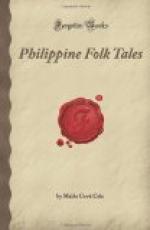[137] First recorded by Emerson B. Christie.
[138] A brass box having three compartments, one for lime, one for the nut, and another for the betel-leaf, which is used in preparing the nut for chewing.
[139] The Subanun have adopted the Moro dress, which consists of long trousers and a coat. The tale shows strong Moro influence throughout. Seven is a mystic and magical number among the Malay. It is constantly used in divination and magical practices and repeatedly occurs in their folk-lore. Skeat explains its importance by referring to the seven souls which each mortal is supposed to possess. See Skeat, Malay Magic, p. 50.
[140] No tales illustrate to better advantage the persistence of old stories and beliefs than do these of the Moro. They are permeated with incidents very similar to those still found among the pagan tribes of the Archipelago, while associated with these are the spirits and demons of Hindu mythology. Finally we find the semi-historical events recorded by the Mohammedanized Malay, the ancestors of the tellers of the tales.
[141] First recorded by N.M. Saleeby.
[142] Those great birds are doubtless derived from Indian literature in which the fabulous bird garuda played such an important part.
[143] A common name in Malay and Sumatran tales.
[144] Probably Solomon of the Old Testament, who is a great historic figure among the Malay and who plays an important part in their romances.
[145] See note 1, p. 28.
[146] In this case of a semi-historic being, whose father was said to be the brother of the earthquake and thunder, we have an interesting blending of mythological and historical facts.
[147] Among Malay people the sultan is the supreme ruler of a district, while petty rulers are known as datos.
[148] Here, as in the Tinguian lore, we find heroes conversing with animals and commanding the forces of nature to come to their aid.
[149] This tale told by the Ilocano is well known among both the Christianized and the wild tribes of the Philippines, and also in Borneo and Java. However, the Ilocano is the only version, so far as known, which has the explanatory element: the reason is given here why monkeys do not eat meat. The turtle is accredited with extraordinary sagacity and cunning. It is another example of the type of tale showing the victory of the weak and cunning over the strong but stupid. See “The Turtle and the Lizard,” p. 86.
[150] All the events here given represent present-day occurrences, and the story appears to have been invented purely to amuse.
[151] The headman of the town.
[152] Here we have an excellent illustration of how a story brought in by the Spaniards has been worked over into Philippine setting. This is doubtless the classical story of Midas, but since the ass is practically unknown in the Philippines, horns (probably carabao horns) have been substituted for the ass’s ears, which grew on Midas’ head. Likewise the bamboo, which grows in abundance, takes the place of the reeds in the original tale.




